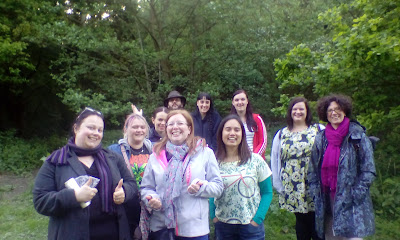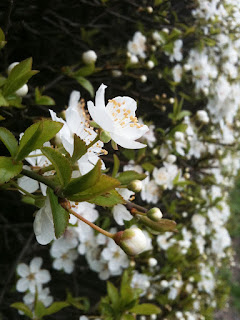 |
| The lovely ladies (and accompanying gentleman) of Buns & Roses WI |
Last Thursday I ventured up to darkest Leeds, put on my trusty foraging hat, and led a few members of Buns and Roses WI around Roundhay Park for guided walk and talk about wild food.
After a grey day, the sun made an appearance just in time for our evening stroll around Roundhay Park, a gorgeous site which is one of the largest municipal parks in Europe (as my legs pointed out afterwards)! We started at the Tropical World entrance, then made our way down to and around the lake and back (my pedometer assures me the round trip is more than the minimum recommended 10,000 steps a day).
 |
| Photo credit Emma Briggs |
The crew soon got used to my verbal shorthand - 'an acquired taste' usually means I've tried it and don't like it. It didn't take long before another theme emerged. You see, I learned most of my foraging because I like making (and drinking) what are referred to as 'country' wines. So yes, most of the edibles I pointed out can also be used to make a very decent wine; I'm not so sure Wild Garlic flower wine is a good idea, but may give a small batch a go anyway - for SCIENCE!
I was originally worried that a managed parkland location might not
have much for the forager, but I needn't have worried - there were
plenty of goodies to point out and talk about. Although many of the
hedgerow species I am used to down here were missing, this was more than
made up for by some magnificent mature trees, including a pair of
walnut trees which I expect the ladies to make the most of! Other useful
tree species in the park include lime, cherry, beech and oak; if you've
never tasted oak leaf wine then I urge you to do so.
 |
| Wine and wild garlic in the woods. Photo credit Emma Briggs. |
We also found the ever present nettles, brambles, chickweed, cleavers and dandelions, but also garlic mustard, wild garlic, common sorrel, and raspberries (flowering but not yet fruiting) - the park definitely holds the makings of a decent meal. We paused a couple of times for examples of the fruits of foraging; one stop to taste wild garlic pesto, which went down quite nicely, and another to taste last year's blackberry wine. It's lovely, with a fruity bouquet and a kick like a donkey good depth of flavour. I gave everyone a couple of wild garlic recipes to try and promised to hand over my recipe for the blackberry wine, so although it's a bit early in the winemaking year, it's at the end of today's blog.
Finally I'd like to thank Buns and Roses for being so welcoming, and asking such interesting questions! It was a real pleasure to be able to pass on some of what I've learned, and I hope that you will all continue to keep an eye out for wild food; remember, what has been seen cannot be unseen!
Recipe: Blackberry Wine
Ingredients
4lb blackberries3lb Sugar
Optional - cup of strong black tea, raisins and juice of half a lemon.
6 pints of water (just boiled)
Yeast (you can buy a sachet of wine yeast from many chemists, I often just use bread yeast)
Method
- Put berries in a bucket, and crush them (a potato masher is ideal for this). Add the optional ingredients if you like at this stage.
- Pour on the hot water. (If you want to add the yeast at this stage you can, but wait until the liquid has cooled to blood temperature).
- Keep covered to prevent flies getting in. I use a clean tea towel if I don't have a lid.
- Stir up once every day for 4-5 days
- Strain off juice and add the sugar (and yeast if not done in step 2).
- Pour mix into a demijohn or jar with an airlock, top up to base of neck with cool boiled water if necessary. Put somewhere dark, and warm if possible - airing cupboard is ideal but you may want to wait until the fermentation has slowed down as it can bubble over!
- Within a day or two it should be bubbling away. Ignore it until it stops bubbling. This can be anywhere from weeks to months. Patience is a virtue!
- Siphon off into another demijohn to leave the sediment in the bottom of the fermenting vessel. You can taste at this stage if it's ready for drinking yet, and see if it's clear. If not, put an airlock on and leave it for another few months. If it is, bottle it into clean sterilised bottles and label - unless you want wine surprise!
